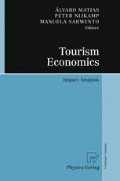Abstract
Generally speaking, competitiveness is a comparative concept of the ability and performance of a firm, sub-sector or country to sell and supply goods and/or services in a given market. At an operational level, instead, competitiveness is viewed in terms of the size of the market share secured by the firm, sub-sector or country considered. Moreover, in an operational context, while identifying that efficiency is a vital factor in competitive markets, it should also be acknowledged that it is, by itself, an insufficient determinant of competitiveness. Indeed, while competitiveness has more to do with “pursuing the correct strategy” towards the conservation and/or increase of the market share, operational efficiency is mainly a measure of how well the firm, sub-sector or country under study processes inputs to achieve its outputs, as compared to its maximum potential for doing so as represented by its production possibility frontier.
Access this chapter
Tax calculation will be finalised at checkout
Purchases are for personal use only
Notes
- 1.
- 2.
The complete set of results of the standard and augmented GMM estimator and the other econometrics are available from the authors upon request.
- 3.
The number of hotels in the chain respects the DEA convention by which the minimum number of DMUs must be greater than three times the sum of the number of inputs and outputs (Raab and Lichty 2002).
References
Anderson RI, Lewis D, Parker M (1999) Another look at the efficiency of corporate travel management departments. J Trav Res 37:267–272
Arellano M, Bond S (1991) Some tests of specification for panel data: Monte Carlo evidence and an application to employment equations. Rev Econ Stud 58:277–297
Arellano M, Bover O (1995) Another look at the instrumental variable estimation of error-components models. J Econometrics 68:29–51
Barros CP (2005) Measuring efficiency in the hotel sector. Ann Tourism Res 32(2):456–477
Barros CP, Mascarenhas MJ (2005) Technical and allocative efficiency in a chain of small hotels. J Hospit Manag 24:415–436
Bergstrand JH (1985) The gravity equation in international trade: some microeconomic foundations and empirical evidence. Rev Econ Stat 67:474–481
Blundell R, Bond S (1998) Initial conditions and moment restrictions in dynamic panel-data models. J Econometrics 87:115–143
Bun JG, Klaassen FJGM (2002) The importance of dynamics in panel gravity models of trade. Working paper, University of Amsterdam
Carrère C (2006) Revisiting the effects of regional trade agreements on trade flows with proper specification of the gravity model. Eur Econ Rev 50:223–247
Caves D, Chistensen LR, Diewert W (1982) The economic theory of index numbers and the measurement of input, output, and productivity. Econometrica 50(6):1393–1414
Charnes A, Cooper WW, Seiford LM (1994) Extension to DEA models. In: Charnes A, Cooper WW, Lewin AY, Seiford LM (eds) Data envelopment analysis: theory, methodology and applications. Kluwer, Dordrecht
Crouch GI (1995) A meta-analysis of tourism demand. Ann Tourism Res 22(1):103–118
Deardorff AV (1998) Determinants of bilateral trade: does gravity work in a neoclassical world? In: Frankel JA (ed) The regionalization of the world economy. University of Chicago Press, Chicago
de Grauwe P, Skudelny F (2000) The impact of EMU on trade flows. Weltwirtschaftliches Arch 136(3):381–402
Eilat Y, Einav L (2004) Determinants of international tourism: a threedimensional panel data analysis. Appl Econ 36:1315–1327
Fare R, Grosskopf S (1992) Malmquist productivity indexes and Fisher ideal indexes. Econ J 102:158–160
Fare R, Grosskopf S, Norris M, Xhang Z (1994) Productivity growth, technical progress, and efficiency change in industrialized countries. Am Econ Rev 84:66–83
Földvári P (2006) The economic impact of the European integration on the Netherlands. A quantitative analysis of foreign trade and foreign direct investments. PhD Dissertation, Utrecht University, the Netherlands
Gat D (1998) Toward a theory of the intra-urban market for hotel services. J R Estate Finance Econ 17(2):199–211
Glick R, Rose AK (2002) Does a currency union affect trade? The time-series evidence. Eur Econ Rev 46:1125–1151
Hwang S, Chang T (2003) Using data envelopment analysis to measure hotel managerial efficiency change in Taiwan. Tourism Manag 24:357–369
Khadaroo J, Seetanah B (2008) The role of transport infrastructure in international tourism development: a gravity model approach. Tourism Manag 29:831–840
Lacagnina V, Provenzano D (2009) An optimized system dynamics approach for a hotel chain management. In: Matias A, Nijkamp P, Sarmento M (eds) Advances in tourism economics – new developments. Springer, Berlin, pp 35–49
Lim C (1997) Review of international tourism demand models. Ann Tourism Res 24(4):835–849
Loree DW, Guisinger SE (1995) Policy and non-policy determinants of US equity foreign direct investment. J Int Bus Stud 26(2):281–299
Mátyás L (1997) Proper econometric specification of the gravity model. World Econ 20:363–368
Naudé WA, Saayman A (2005) The determinants of tourist arrivals in Africa: a panel data regression analysis. Tourism Econ 11(3):365–391
Oliveira MM, Gaspar MB, Paixão JP, Camanho AS (2009) Productivity change of the Artisanal Fishing Fleet in Portugal: a Malmquist index analysis. Fish Res 95:189–197
Powersim Studio (2005) Academic Kit, Powersim Software – The Business Simulation Company, http://www.powersim.com
Raab R, Lichty R (2002) Identifying sub-areas that comprise a greater metropolitan area: the criterion of county relative efficiency. J Reg Sci 42:579–594
Shephard RW (1953) Cost and production functions. Princeton University Press, Princeton
Song H, Witt SF, Jensen TC (2003) Tourism forecasting: accuracy of alternative econometric models. Int J Forecasting 19:123–141
Wall HJ (2000) Gravity model specification and the effects of the Canada-U.S. border. Working Paper, Federal Reserve Bank of St. Louis
Witt SF, Witt CA (1995) Forecasting tourism demand: a review of empirical research. Int J Forecasting 11:447–475
Author information
Authors and Affiliations
Corresponding author
Editor information
Editors and Affiliations
Rights and permissions
Copyright information
© 2011 Springer-Verlag Berlin Heidelberg
About this chapter
Cite this chapter
Lacagnina, V., Provenzano, D. (2011). Hotel Chain Performance: A Gravity-DEA Approach. In: Matias, Á., Nijkamp, P., Sarmento, M. (eds) Tourism Economics. Physica-Verlag HD. https://doi.org/10.1007/978-3-7908-2725-5_11
Download citation
DOI: https://doi.org/10.1007/978-3-7908-2725-5_11
Published:
Publisher Name: Physica-Verlag HD
Print ISBN: 978-3-7908-2724-8
Online ISBN: 978-3-7908-2725-5
eBook Packages: Business and EconomicsEconomics and Finance (R0)

